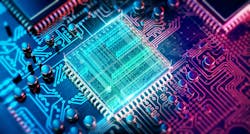Magnetoresistive RAM (MRAM) continues to make strides, finding more uses as capacity and performance have increased. The long-term goal is a universal, nonvolatile memory. It has a growing partner ecosystem including support by the major fabs.
Electronic Design Editor Bill Wong talked with Kevin Conley, President and CEO of Everspin Technologies, about the state of MRAM and its viability as a universal memory technology.
MRAM is a more expensive persistent memory. What value does it provide to justify its price tag? More expensive than what?
Toggle MRAM is fairly price competitive with other low-density persistent-memory technologies and STT-MRAM really has no equivalent technology that provides the same levels of endurance, performance, and persistence. MRAM combines the unique value proposition of persistence, performance, and endurance to a degree unrivaled by any other memory technology, coupled with impeccable reliability and ease of operation (byte addressability, no wear leveling, etc). MRAM simplifies system architecture where protection of data in the event of power loss is paramount, eliminating the need for less reliable power storage such as batteries and supercapacitors.
STT-MRAM is often compared to DRAM on a cost-per-bit basis and called expensive, but it needs to be recognized that STT-MRAM isn’t generally used to replace DRAM. The economic benefits of STT-MRAM are the reduction in use of unreliable capacitors or batteries, increase in available physical space for other memory technologies (e.g., NAND memory in SSDs or AFAs), and it helps to enable higher-performing products in a shorter time frame through simpler architectures. All of these value drivers help our customers capture more value in their products, thus offsetting any expense from the integration of our MRAM memories.
You mentioned you reached production on your 1-Gb discrete STT-MRAM and now several ecosystem controller partners have signed on to enable the device. Why were partners so excited to support 1-Gb STT-MRAM?
The higher density allows applications, such as enterprise SSDs, to use fewer chips to accomplish their system goals. As storage form factors continue to reduce in size and volume, board space and system cooling become more critical, furthering the need for a higher-density chip. These goals of low latency and high performance are important to the large data-center operations, especially as QLC memory with latency, which is significantly higher than current memories, starts to be adopted more broadly in leading storage applications. In addition, the DDR4-based interface of the 1-Gb device is more prevalent than DDR3 of the 256-Mb, making the 1-Gb more adaptable in today’s architectures.
Since Everspin is the only supplier in discrete MRAM, what are your competitors doing to enter the space?
Some companies are trying to follow us in productizing discrete MRAM memories, but they are significantly trailing in product maturity and density. Today we’re not aware of any other companies with discrete MRAM offerings that are in production. And while competitors are marketing their future technologies that they intend to manufacture, as of yet, there are none we know of with products targeted in the gigabit density range.
Historically, a broader set of companies have invested in MRAM research. Some attempts have not been successful and efforts have ceased or been scaled back and are on life support, while others have been redirected exclusively to focus on embedded MRAM.
Embedded MRAM is certainly a validation of MRAM as a broad memory technology. Who is leading this charge, and how is Everspin helping the embedded MRAM market?
The logic foundries need a technology to replace SoC-embedded NOR flash as a non-volatile code store and face challenges with SRAM that’s not scaling efficiently (costly) and increasing in power. MRAM brings non-volatility with an easier integration path than NOR flash, and it has a scaling path with low leakage, making it a logical successor to SRAM. All major foundries have announced MRAM programs (TSMC, Samsung, Intel, GLOBALFOUNDRIES/GF, UMC) with TSMC, Samsung, Intel, and GF announcing production readiness or shipments. Everspin has a licensing agreement and solid partnership with GF and has jointly helped develop their 22-nm embedded MRAM offering.
What are the latest developments in STT-MRAM and Toggle?
STT-MRAM products continue to scale and increase in density. A 1-Gb memory is now available from Everspin with 10 years of data retention, featuring a DDR4-compatible interface and DRAM-like speed. On Toggle, we’re introducing a 32-Mb version of our popular 16-Mb product in response to demand from customers for higher density. Now customers have MRAM Toggle options from 128 kb to 32 Mb in all temperature ranges, including automotive. STT and Toggle serve unique markets, and we continue to develop products in both technologies to serve our existing and new customers.
Kevin Conley has served as the President and CEO of Everspin since Sept 2017 and as a member of the Everspin Board of Directors since March 2017. Prior to joining Everspin, Kevin spent over 20 years at SanDisk, where he was most recently Senior Vice President and CTO until June 2016, focused on fostering strategic innovation at the company. Previously, he served as senior vice president and general manager of SanDisk’s Client Storage Solutions after holding several key system engineering leadership positions over his career at the company.
About the Author
William G. Wong
Senior Content Director - Electronic Design and Microwaves & RF
I am Editor of Electronic Design focusing on embedded, software, and systems. As Senior Content Director, I also manage Microwaves & RF and I work with a great team of editors to provide engineers, programmers, developers and technical managers with interesting and useful articles and videos on a regular basis. Check out our free newsletters to see the latest content.
You can send press releases for new products for possible coverage on the website. I am also interested in receiving contributed articles for publishing on our website. Use our template and send to me along with a signed release form.
Check out my blog, AltEmbedded on Electronic Design, as well as his latest articles on this site that are listed below.
You can visit my social media via these links:
- AltEmbedded on Electronic Design
- Bill Wong on Facebook
- @AltEmbedded on Twitter
- Bill Wong on LinkedIn
I earned a Bachelor of Electrical Engineering at the Georgia Institute of Technology and a Masters in Computer Science from Rutgers University. I still do a bit of programming using everything from C and C++ to Rust and Ada/SPARK. I do a bit of PHP programming for Drupal websites. I have posted a few Drupal modules.
I still get a hand on software and electronic hardware. Some of this can be found on our Kit Close-Up video series. You can also see me on many of our TechXchange Talk videos. I am interested in a range of projects from robotics to artificial intelligence.


